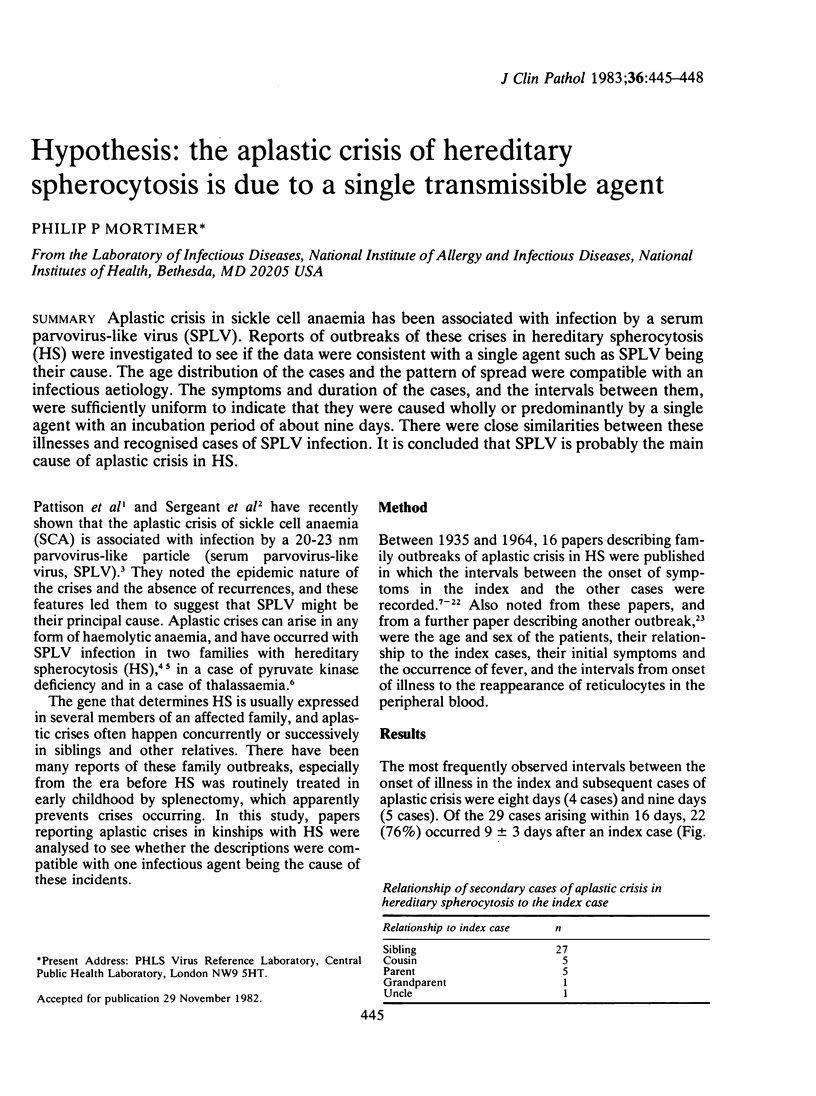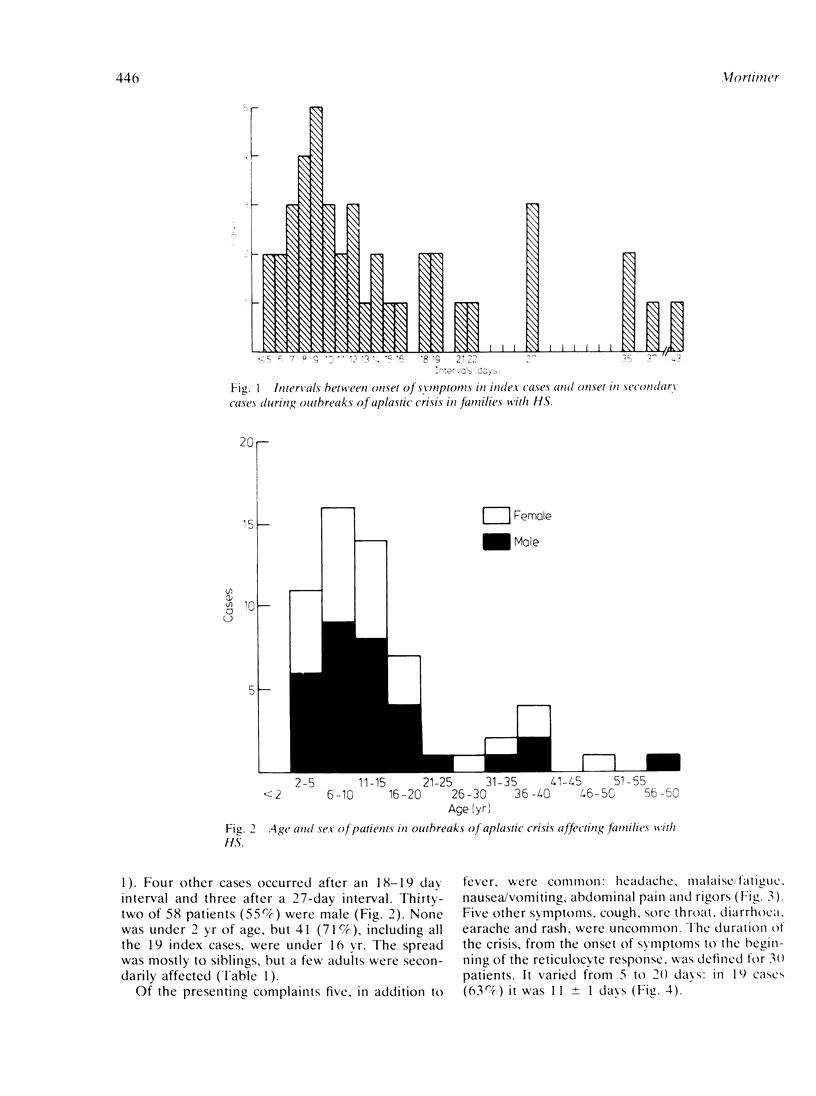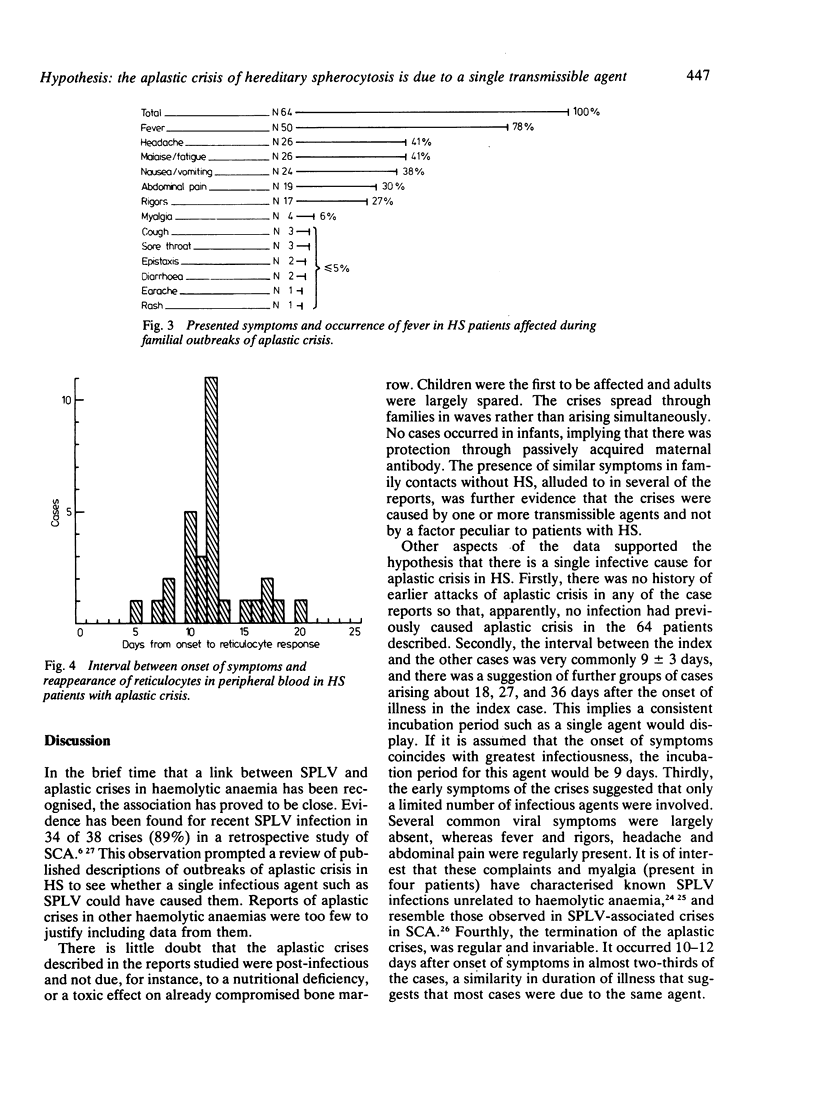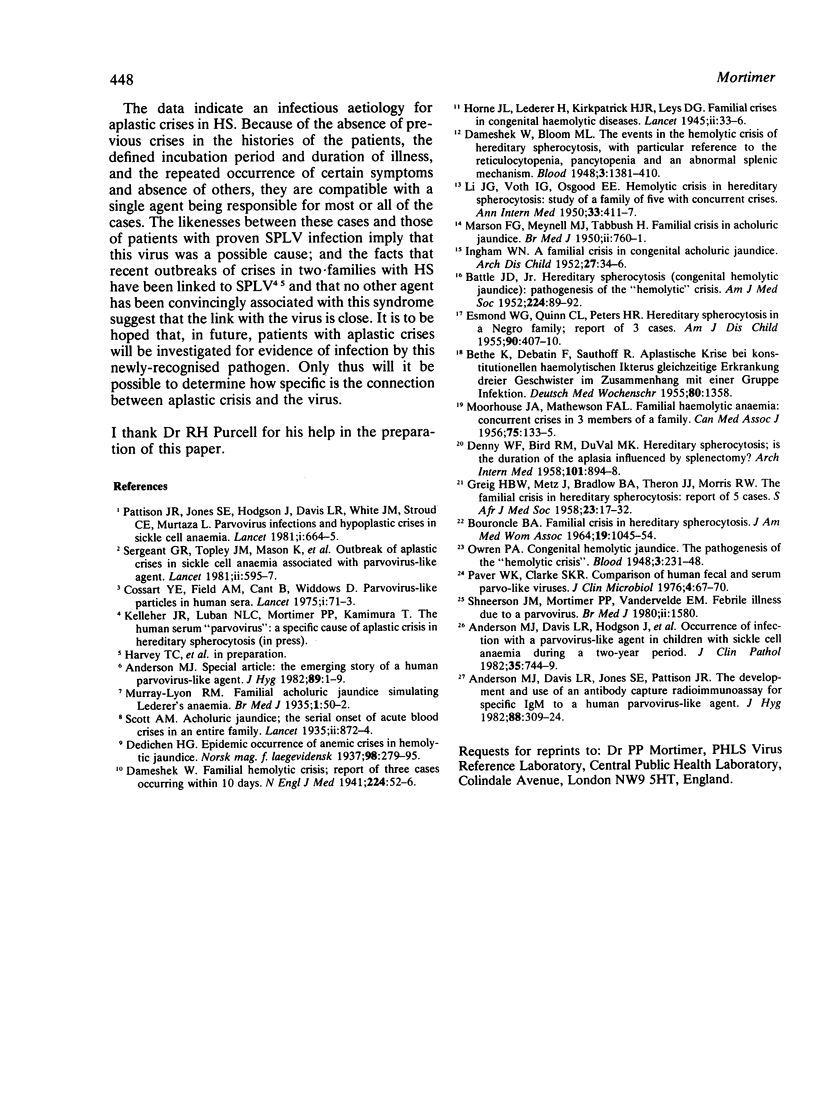Abstract
Aplastic crisis in sickle cell anaemia has been associated with infection by a serum parvovirus-like virus (SPLV). Reports of outbreaks of these crises in hereditary spherocytosis (HS) were investigated to see if the data were consistent with a single agent such as SPLV being their cause. The age distribution of the cases and the pattern of spread were compatible with an infectious aetiology. The symptoms and duration of the cases, and the intervals between them, were sufficiently uniform to indicate that they were caused wholly or predominantly by a single agent with an incubation period of about nine days. There were close similarities between these illnesses and recognised cases of SPLV infection. It is concluded that SPLV is probably the main cause of aplastic crisis in HS.
Full text
PDF



Selected References
These references are in PubMed. This may not be the complete list of references from this article.
- Anderson M. J., Davis L. R., Hodgson J., Jones S. E., Murtaza L., Pattison J. R., Stroud C. E., White J. M. Occurrence of infection with a parvovirus-like agent in children with sickle cell anaemia during a two-year period. J Clin Pathol. 1982 Jul;35(7):744–749. doi: 10.1136/jcp.35.7.744. [DOI] [PMC free article] [PubMed] [Google Scholar]
- Anderson M. J., Davis L. R., Jones S. E., Pattison J. R., Serjeant G. R. The development and use of an antibody capture radioimmunoassay for specific IgM to a human parvovirus-like agent. J Hyg (Lond) 1982 Apr;88(2):309–324. doi: 10.1017/s0022172400070169. [DOI] [PMC free article] [PubMed] [Google Scholar]
- Anderson M. J. The emerging story of a human parvovirus-like agent. J Hyg (Lond) 1982 Aug;89(1):1–8. doi: 10.1017/s0022172400070480. [DOI] [PMC free article] [PubMed] [Google Scholar]
- BETKE K., DEBATIN F., SAUTHOFF R. Aplastische Krise bei konstitutionellem hämolytischen Ikterus; gleichzeitige Erkrankung dreier Geschwister im Zusammenhang mit einer Grippe-Infektion. Dtsch Med Wochenschr. 1955 Sep 16;80(37):1358–1360. doi: 10.1055/s-0028-1116203. [DOI] [PubMed] [Google Scholar]
- BOURONCLE B. A. FAMILIAL CRISIS IN HEREDITARY SPHEROCYTOSIS. REPORT OF 5 CASES IN 2 FAMILIES. J Am Med Womens Assoc. 1964 Dec;19:1045–1054. [PubMed] [Google Scholar]
- DENNY W. F., BIRD R. M., DUVAL M. K. Hereditary spherocytosis; is the duration of the aplastic crisis influenced by splenectomy. AMA Arch Intern Med. 1958 May;101(5):894–898. doi: 10.1001/archinte.1958.00260170050007. [DOI] [PubMed] [Google Scholar]
- ESMOND W. G., QUINN C. L., PETERS H. R. Hereditary spherocytosis in a Negro family; report of three cases. AMA Am J Dis Child. 1955 Oct;90(4):407–410. [PubMed] [Google Scholar]
- GREIG H. B., METZ J., BRADLOW B. A., THERON J. J., MORRIS R. W. The familial crisis in hereditary spherocytosis: report of five cases. S Afr J Med Sci. 1958 Apr;23(1):17–32. [PubMed] [Google Scholar]
- INGHAM W. N. A familial crisis in congenital acholuric jaundice. Arch Dis Child. 1952 Feb;27(131):34–36. doi: 10.1136/adc.27.131.34. [DOI] [PMC free article] [PubMed] [Google Scholar]
- LI J. G., VOTH I. G., OSGOOD E. E. Hemolytic crisis in hereditary spherocytosis: study of a family of five with concurrent crises. Ann Intern Med. 1950 Aug;33(2):411–417. doi: 10.7326/0003-4819-33-2-411. [DOI] [PubMed] [Google Scholar]
- MARSON F. G., MEYNELL M. J., TABBUSH H. Familial crisis in acholuric jaundice. Br Med J. 1950 Sep 30;2(4682):760–761. doi: 10.1136/bmj.2.4682.760. [DOI] [PMC free article] [PubMed] [Google Scholar]
- MOORHOUSE J. A., MATHEWSON F. A. Familial haemolytic anaemia: concurrent crises in three members of a family. Can Med Assoc J. 1956 Jul 15;75(2):133–135. [PMC free article] [PubMed] [Google Scholar]
- Opie L. H. Letter: Exercise, sport, and sudden death. Lancet. 1975 May 17;1(7916):71–73. [PubMed] [Google Scholar]
- Pattison J. R., Jones S. E., Hodgson J., Davis L. R., White J. M., Stroud C. E., Murtaza L. Parvovirus infections and hypoplastic crisis in sickle-cell anaemia. Lancet. 1981 Mar 21;1(8221):664–665. doi: 10.1016/s0140-6736(81)91579-8. [DOI] [PubMed] [Google Scholar]
- Paver W. K., Clarke S. K. Comparison of human fecal and serum parvo-like viruses. J Clin Microbiol. 1976 Jul;4(1):67–70. doi: 10.1128/jcm.4.1.67-70.1976. [DOI] [PMC free article] [PubMed] [Google Scholar]
- Serjeant G. R., Topley J. M., Mason K., Serjeant B. E., Pattison J. R., Jones S. E., Mohamed R. Outbreak of aplastic crises in sickle cell anaemia associated with parvovirus-like agent. Lancet. 1981 Sep 19;2(8247):595–597. doi: 10.1016/s0140-6736(81)92739-2. [DOI] [PubMed] [Google Scholar]
- Shneerson J. M., Mortimer P. P., Vandervelde E. M. Febrile illness due to a parvovirus. Br Med J. 1980 Jun 28;280(6231):1580–1580. doi: 10.1136/bmj.280.6231.1580. [DOI] [PMC free article] [PubMed] [Google Scholar]


